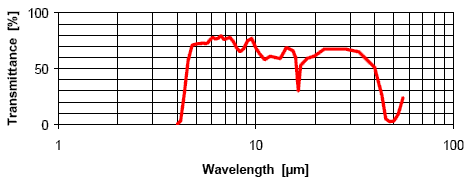Kipp & Zonen CG4 Pyrgeometer
Purpose of instrument:-
The CG4 pyrgeometers are used for the measurement of upwelling and downwelling components of LW irradiance
(in W m-2).
The instruments are sensitive to infrared radiation in a wavelength range of 4.5 to approx.
40mm, and have a field of view of 180o, with
a cosine response.
Principles of operation:-
The CG4 pyrgeometer uses a thermopile to detect thermal gradients caused by incoming radiant energy.
The detecting element is a black painted disk, which absorbs the incoming radiation, and the heat flows
through to the heatsink, which is the instrument body.
The thermal gradient across the thermopile produces a voltage which is proportional to the net radiation.
(ie the difference between the radiation received at the detector, and the radiation emitted
by the pyrgeometer itself).
The nominal sensitivity of the thermopile is 10mV/W/m2
The spectral range of the incoming radiation is restricted by a specially coated silicon window, which
filters out unwanted solar radiation below wavelengths of 4.5mm.
The silicon window is also required to protect the instrument from environmental effects, such as wind and rain.
The curve below shows the transmittance characteristics of the silicon window:-
 |
|
NB: Source - Kipp & Zonen CG4 manual
|
In order to calculate the incoming LW irradiance at the detector, the temperature of the
pyrgeometer body must be known. This is measured using a thermistor (type YSI44031), which is located
beside the cold junctions of the thermopile. The downward (or upward) longwave radiation is then
calculated using the following formula :-
LW = Uemf/S + ( 5.67*10-8 * Tb4 )
where Uemf is the output voltage from the thermopile, S
is the calibration constant of the instrument, and Tb is the pyrgeometer body
temperature, measured by the thermistor, in degrees kelvin.
Note that for an upward facing pyrgeometer, the thermopile output voltage will in most instances be negative.
This is beacause the upwelling irradiance from the pyrgeometer is likely to be greater then the incoming
irradiance from the sky.
Window heating affects (caused by solar radiation creating a thermal gradient between the window and
the thermopile detector) are very small in the CG4. The manufacturer has estimated that in full sunlight,
the heating offset is less than 4 W/m2. However, to minimise this effect,
the direct beam of the sun can be obscured by use of a solar track. (see section on instrument setup).
Futher information on the CG4 pyrgeometer can be obtained from the manufacturer's website:-
www.kippzonen.com
Instrument setup:-
The CG4 pyrgeometer measuring the downwelling LW irradiance, is mounted on a Kipp & Zonen 2AP solar tracker.
This tracks the sun through the sky, such that the dome is continuously shaded from the direct beam of the sun
by a small black sphere. This reason for this is to eliminate any window heating affects as described above.
For measuring the upwelling LW irradiance from the ground, the CG4 pyrgeometer is mounted, facing downwards,
at the end of a boom, clamped onto a mast at a height of 2m. The boom extends out about 1.5m in a southerly
direction. The ground beneath the instrument, is short grass, and is representative of the whole of the
site.
Both the instruments are ventilated by a fan which blows air across the domes. This prevents dew and rain
droplets etc from collecting.
Calibration:-
The sensitivity of each instrument is determined initially, by the manufacturer by comparison against a standard
instrument, traceable back to the World Radiation Centre in Davos. A spare, reference CG4 is held at Cardington
for intercomparisons.
Maintenance:-
The following tasks are carried out on a weekly basis :- checking the operation of the ventilators,
checking for dirt on the domes and checking the condition of the dessicant. The domes are cleaned when required.


